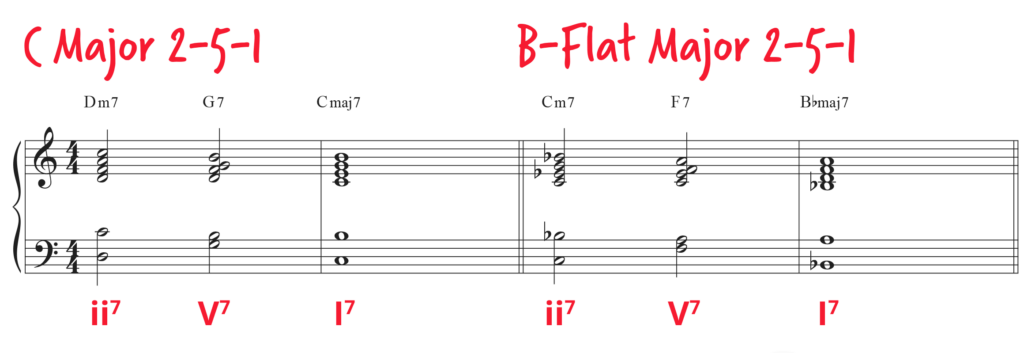Want to play jazz piano? Then you need to get familiar with these three essential jazz progressions! Jazz piano is all about progressions, harmony, and how we get creative within that space. Start with these basic progressions and build a foundation of vocabulary you can then use to go further in your jazz piano journey.
In this lesson:
To get the most out of this lesson, you should already be familiar with 7th chords, inversions, diatonic chords, and the number system. If this lesson feels too advanced for you, check out these related foundational lessons first:
Subscribe to The Note for exclusive interviews, fascinating articles, and inspiring lessons delivered straight to your inbox. Unsubscribe at any time.
Our first progression is named after George Gershwin’s “I Got Rhythm.” You can also find it in popular jazz standards like “Rhythm-A-Ning” (Thelonious Monk), “Anthropology” (Charlie Parker/Dizzy Gillespie), and “Cotton Tail” (Duke Ellington).
Now, the original Rhythm Changes is 32 measures long because it has several repeated parts. Over the years, many variations of this progression have appeared. But at its core, Rhythm Changes consists of the following A section and B section progressions:
Section A:
I7 – vi7 – ii7 – V7
In C major: Cmaj7 – Am7 – Dm7 – G7
Section B:
iii7 – V7/ii – ii7 – V7
In C major: Em7 – A7 – Dm7 – G7
In standard notation, the progression looks like this:

Section B is basically the Circle of Fifths progression. If you look carefully, it’s a pattern of descending fifths.
You may notice that we use A7 instead of Am7 (C major’s diatonic vi chord) in Section B. This is called a secondary dominant (V7/ii). The A7 is the dominant 7th chord of the next chord (Dm7) and has a stronger pull towards that chord.
If you want to get a feel of how this sounds, check out our friend and Pianote Coach Sangah Noona jamming to “I Got Rhythm”:
Ready for to take things to the next level? Try playing this progression in a syncopated comping pattern with a chromatic walking bass line. Here’s one example of what you can do:

Next up we have a beautiful minor chord progression. This progression sounds gorgeous because of two things: 1) a chromatically descending bassline; and 2) minor 9th voicings.

When we talk about 9ths, 11ths, and 13ths, these are called chord extensions. You can think of them as extending the chord more than an octave. The 9th interval sounds so nice because, by being further from the root, it adds just the right amount of tension without being too dissonant.
You can hear this progression at a transitional point in the B section of the jazz standard “Autumn Leaves.” Hear Sangah Noona play it here.
Finally, we have the building block of jazz: the 2-5-1 progression. You’ll find this little progression everywhere, and not just in jazz. Maroon 5’s “Sunday Morning” is also a cycle of repeating 2-5-1s!
It’s important to know your 2-5-1s in every key so that you can throw them into improvisation at will. In the lesson video, I’ll go over a voicing pattern that’s easy to transition through. Basically, on our right hand, we play a root position ii7 chord, a second inversion V7 chord, and a root position I7 chord.

For a more in-depth discussion on the 2-5-1, how to practice it, and how to use it in your jazz improvisations, check out our lesson and Bench episode here. We’ve also included a cycle of descending 2-5-1s you can practice in the free resource below. This practice lists 2-5-1s in six keys. To find the 2-5-1s in the remaining six keys, start the cycle a semitone higher (Ebm7-Ab7-Dbmaj7).
For an easy reference to these chord progressions in C major, download our sheet music resource for free:
Pianote Members can also use the Practice-Along feature in the Members Area to loop these progressions. That’s the best way to learn how to play jazz—loop a progression and solo over it! If you’re not a Member yet, here’s a free trial, just for you!
As a Pianote Member, you’ll get access to our 10-step Method, song library, and growing community of piano players just like you. Plus: get coached by world-class pianists and learn whenever you want, wherever you want, and whatever you want.
TRY PIANOTE FOR 7 DAYSKevin Castro is a graduate of the prestigious MacEwan University with a degree in Jazz and Contemporary Popular Music, and is the Musical Director and touring pianist for JUNO-winning Canadian pop star, JESSIA. As your instructor at Pianote, Kevin is able to break down seemingly complex and intimidating musical concepts into understandable and approachable skills that you can not only learn, but start applying in your own playing. Learn more about Kevin here.
/marketing/pianote/promos/april/banner-bg-m.webp)
We use cookies for traffic data and advertising. Cookie Policy »
/marketing/pianote/promos/april/banner-title.webp)